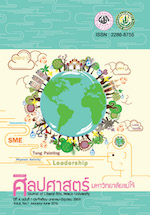ลูกหลานกุลาบ้านโนนใหญ่จากครอบครัวพ่อค้าเร่สู่วิถีแรงงานอีสาน พ.ศ.2500-2525 (Descendents of the Kula of Non Yai Village: From Families of Travelling Merchants to the Isan Labor Force between BE 2500-2525)
Main Article Content
บทคัดย่อ
งานศึกษานี้เป็นส่วนหนึ่งของโครงการทำนุบำรุงศิลปวัฒนธรรมเรื่องการรวบรวม ข้อมูลกลุ่มชาติพันธุ์กุลาในจังหวัดอุบลราชธานี กับจังหวัดยโสธร ดัวยมุมมองทางประวัติศาสตร์ กุลาเป็นคำที่คนล้านนาใช้เรียกคนต่างถิ่น ชุมชนโนนใหญ่ได้ใช้คำเรียกคนต่างถิ่นว่ากุลา เช่นเดียวกัน แต่กุลากลับเรียกตัวเองว่าต่องสู่มาจากประเทศพม่า เป็นหนึ่งในกลุ่ม ชาติพันธุ์กะเหรี่ยงดำ หรือปะโอ ที่เขามาตั้งรกราก ณ บ้านโนนใหญ่ตั้งแต่สมัยรัชกาลที่ 4 แห่งกรุงรัตนโกสินทร์ มีอาชีพเป็นพ่อค้าเร่ มีฐานะเป็นเขยสู่ในชุมชนไทลาว ในปีพ.ศ.2480 ได้เริ่มมีการขึ้นทะเบียนคนต่างด้าว ทางการสยามได้จัดกลุ่มกุลาชุมชนโนนใหญ่ ในฐานะคนต่างด้าว ที่มีนามสกุลว่าต่องสู่ ต่อมาลูกหลานกุลาได้เปลี่ยนไปใช้นามสกุล มารดา และสืบทอดวัฒนธรรมไทลาวเป็นหลัก เนื้อหาของงานมี 3 ส่วน ได้แก่ภูมิหลังที่มา ของชุมชนโนนใหญ่ ประวัติศาสตร์กุลาโนนใหญ่ ลูกหลานกุลาโนนใหญ่ในวิถีแรงงานอีสาน ผลการศึกษาพบว่า ช่วงปีพ.ศ.2500 - 2525 มีลูกหลานกุลาบ้านโนนใหญ่ได้เลือกละ ทิ้งบ้านเกิดเมืองนอน เพื่อดำรงชีวิตในพื้นที่ภาคใต้ และกรุงเทพมหานคร กรณี การขายแรงงาน ในพื้นที่ภาคใต้ ประกอบอาชีพคนงานตัดไม้ฟืนรถไฟ คนงานเหมืองแร่ ในพื้นที่กรุงเทพมหานคร เป็นคนงานเฝ้าโกดัง คนขับรถสามล้อเครื่องรับจ้าง มูลเหตุในการขายแรงงานต่างถิ่น คือ ความยากจน และความต้องการแสวงหาโชคลาภอย่างนักผจญภัยเช่นบรรพบุรุษ วิถีแรงงานอีสานของกลุ่มศึกษานี้ ได้ค้นพบถึง การนำใช้แผนพัฒนาเศรษฐกิจและสังคมแห่งชาติเป็นปัจจัยสำคัญประการหนึ่งใน การพลิกผันชีวิตลูกหลานกุลาเข้าสู่ระบบแรงงาน ผลการศึกษาได้ค้นพบว่า ลูกหลานกุลาโนนใหญ่ คือ ตัวอย่างของชุมชนที่มีความหลากหลายทางเชื้อชาติและวัฒนธรรม แต่สามารถดำรงชีวิต ได้อย่างกลมกลืน และเป็นอันหนึ่งอันเดียวกับชุมชนไทลาว ซึ่งเป็นเอกลักษณ์ที่โดดเด่น ประการหนึ่งในสังคมและวัฒนธรรมอาเซียน
Maintenance Project entitled ‘Compilation of Historical Information on the Kula Ethnic in Ubon Ratchathani and Yasothorn Provinces.’ ‘Kula’ is a term originally used by Lanna people to refer to people of other origins. This term was later adopted by native villagers of Non Yai Village. The Kula, however, call themselves ‘tong su’, an ethnic subgroup of the Black Karen or Pa-O ethnicity originally from Burma. During King Rama IV’s reign, the male Kula travelled to Non Yai Village as merchants and settled there as ‘koei sui’ (a term describing sons-in-law who are not native to the village) in this Tai-Lao community. In BE 2480 (1937 AD) foreigner registration was mandated, and the Siamese Government thus categorized the Kula in the Non Yai community as ‘foreigners’ with the last name ‘Thongsu.’ Later, younger generations of Kula started to adopt their mothers’ last names and practice Tai-Lao cultures. This research covers three sub-topics, namely, the background of the Non Yai community, the history of the Kula in Non Yai, and Kula descendents in the Isan labor force. The findings show that between BE 2500-2525 (1942-1977 AD), younger Kula abandoned their native village for life in Thailand’s South construction and Bangkok. Those who took labor jobs became lumberjacks in the railroad construction and mine workers. Those who worked in Bangkok became warehouse guards and auto rickshaw drivers. Motivating factors were poverty and the adventurous drive to seek fortune like their ancestors. Life as laborers indicated that the National Economic and Social Development Plans pushed them into the labor force. The findings also show that descendents of Kula in the Non Yai community are an exemplar of ethnic and cultural heterogeneity, and yet they live in harmony with the Tai-Lao community. This is one unique social and cultural trait in the ASEAN community.

